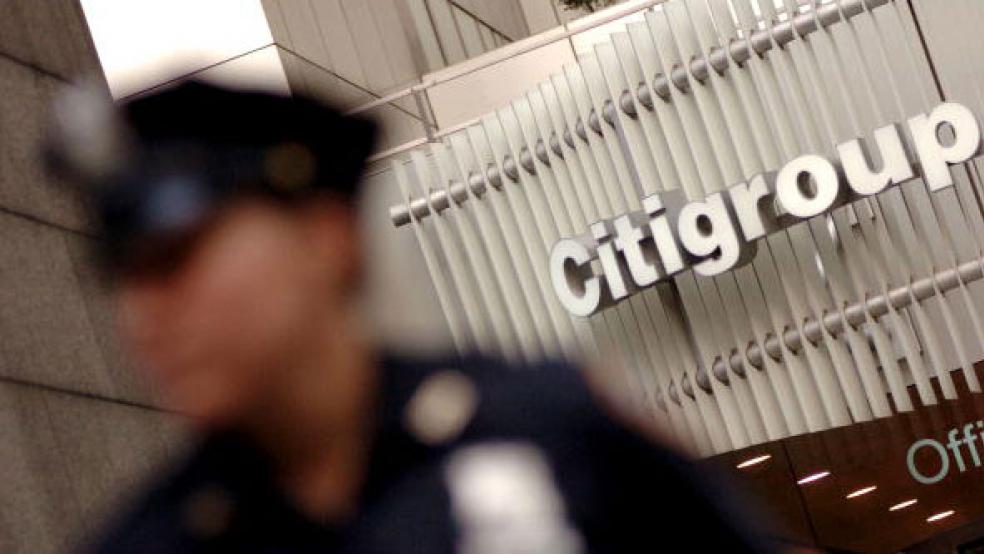Bank stock investors have ample causes to celebrate this spring. Not only are their share prices soaring – the financials group within the S&P 500 posted a return that was more than double the already hefty gain from the broad index during the first quarter – but even the most troubled of big banks are generating earnings that surpass analyst expectations.
Goldman Sachs (GS) this morning announced earnings of $3.92 a share for the just-ended first quarter, better than the $3.55 per share analyst consensus, despite the fact that underwriting activity and merger activity slumped during the period. As an extra treat for investors, the company announced its first dividend increase in six years.
Goldman isn’t alone in exceeding analyst expectations. Last week, JP Morgan Chase (JPM) reported net income of $1.31 a share, up from $1.28 in the year-earlier period and far better than the Wall Street estimate of $1.18 a share. Even hapless Citigroup (C) – which had the Fed reject its plan to boost its dividend for shareholders, and then saw those irritated shareholders vote against CEO Vikram Pandit’s compensation plan at today’s annual meeting in Dallas – did better than analysts had predicted.
There is a big “but” here, though. While these figures are stronger than expected, few of them signal any real fundamental strength for the banking industry.
True, many of the worst of the sector’s woes are behind them: Toxic loans have been provided for on balance sheets; fresh capital has been raised. But the crisis continues to weigh on them either directly – JP Morgan announced a $2.5 billion reserve for litigation expenses linked to its mortgage business, while Citigroup had a tangled mess of writedowns and other items cluttering up its own financial statements – or indirectly. Above all, it’s not yet clear whether these institutions will return to generating the same kinds of returns for their investors that they did in the decades leading up to the crisis – whether they have figured out new ways to be profitable rather than just slashing their costs in order to minimize the declines in profitability they must report to shareholders.
Such cuts are part of what fueled the positive earnings surprise that Goldman Sachs delivered early this morning. The company’s headcount is down 8 percent; it set aside only $4.4 billion for compensation and benefits (including estimated year-end bonuses) compared to $5.2 billion in the same period last year. Cost-cutting helped, but while the company’s earnings were upbeat compared to analysts’ expectations, they still were 23 percent below where they were last year. Being “better than expected” isn’t going to be good enough for very long, even with a small boost in the dividend to sweeten the pot. That’s why Goldman’s stock price, had fallen nearly 1 percent to $116.70 by early afternoon.
Goldman also has yet to learn that perceptions matter, or, at least, how to manage those perceptions. Greg Smith, the erstwhile banker who resigned very publicly earlier this year in an op-ed column in The New York Times and who went on to ink a book contract worth seven figures (more than he might have earned in a bonus this year) probably wasn’t a great loss to the investment bank. Insiders point out he headed a department of one person, and wasn’t really as much a part of the bank’s inner circles as he would like to portray himself.
Still, Goldman can’t seem to shake its “foot in mouth” disease as it tries to steer through the Smith-induced public relations mess by protesting that it really does treat all clients equally. The reality: No Wall Street institution does (there’s a big difference between a counterparty and a client to whom a fiduciary duty is owed) and the protestations simply make Goldman look silly.
David Viniar’s comments on today’s earnings conference call with analysts were no more impressive. The chief financial officer appeared to shrug off the ongoing review by Moody’s of the credit ratings of 17 of the largest banking institutions, including Goldman Sachs. “We cannot figure out why they are where they are” with their analysis, he said, a remark that ended up sounding dismissive to at least one of the analysts on the call. After all, Viniar commented, Goldman Sachs is well-known for its analytical skills. That is almost certainly true – but there is a way to phrase comments like that that doesn’t remind people that your firm was once memorably described as a giant vampire squid.
Banks are definitely bouncing back from the abyss in which they found themselves in the wake of the financial crisis. To some extent, the recent rally in stock prices has simply driven these shares closer to fair market value; investors this week are likely to continue to celebrate the fact that the first quarter wasn’t worse than it turned out to be. But how much further can banks cut costs? What new sources of profit can they identify? The future isn’t without external headwinds, either. There are the regulators – how will they interpret new rules and restrictions on banks? There is Europe – can countries like Greece and Spain really stave off financial collapse? There is still risk aversion on the part of investors, which continues to rein in dealmaking.
When those questions can be answered, then it’s appropriate to talk about a new bull market for financial stocks. For now, it’s still a relief rally.






